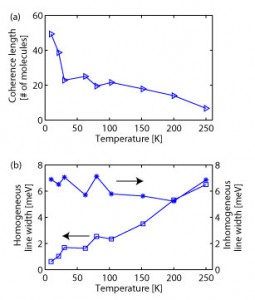Exciton Delocalization and Disorder in J-aggregates
- Category: Materials
- Tags: Katherine Stone, Vladimir Bulovic
J-aggregates, which are self-assembling molecular nanostructures [1] , have unique optical properties resulting from coherent coupling of their molecular components. For instance, J-aggregate films a few nanometers thick can strongly absorb light, making them interesting candidates for applications involving strong coupling in a microcavity [2] . In a J-aggregate, the peak absorption wavelength is red-shifted and narrowed with respect to the peak absorption wavelength of its molecular components due to dipole-dipole coupling, which produces a collective excitation, called an exciton, that is delocalized over the nanostructure [3] . Static and dynamic disorder in the aggregate affects the number of molecules over which the exciton is delocalized, therefore broadening the absorption line width. We use 2D Fourier transform optical spectroscopy to quantify the exciton size and determine its relationship to inhomogeneous (static) and homogeneous (dynamic) broadening.
Figure 1(a) shows a 2D correlation spectrum of a film of BIC [4] J-aggregates deposited on a sapphire substrate and cooled to 6 K in a cryostat. The negative-going (blue) feature indicates bleaching of the exciton transition while the positive-going (red) feature indicates excited state absorption to a two-exciton state. The energy separation of the two features is related to the exciton size [5] , similar to the model for a quantum-mechanical “particle-in-a-box.” Figure 1(b) shows the dependence of the exciton size on its absorption energy. Figure 1(c) shows that the average exciton size given by the pump-probe spectrum (17 molecules) does not reflect the value of the energy-dependent delocalization since the pump-probe peaks are broadened due to the inhomogeneity of the film. As the temperature increases, the exciton size decreases, as Figure 2(a) shows, due to increased exciton-phonon scattering. The homogeneous line width also increases as the temperature increases, as in Figure 2(b), while the inhomogeneous line width remains constant, indicating that dynamic disorder influences the exciton size more strongly.
- Figure 1: (a) 2D correlation spectrum of BIC J-aggregates. The black lines indicate the minima and maxima of the spectral feature with respect to the exciton absorption energy. (b) Coherence length, N, as a function of exciton absorption energy. The coherence length of the lowest energy exciton is 48 molecules. (c) Projection of the 2D correlation spectrum to the exciton emission energy axis (equivalent to a pump-probe spectrum) yields an exciton coherence length of 17 molecules.
- Figure 2: The dependence of the exciton size (a) and homogeneous (squares) and inhomogeneous (asterisks) line widths (b) on temperature.
- E. Jelley, “Spectral absorption and fluorescence of dyes in the molecular state,” Nature, vol. 138, pp. 1009-1010, Dec. 1936. [↩]
- J. R. Tischler, M. S. Bradley, Q. Zhang, T. Atay, A. Nurmikko, and V. Bulovic, “Solid-state cavity QED: Strong coupling in organic thin films,” Organic Electronics, vol. 8, pp 94-113, Jan. 2007. [↩]
- T. Kobayashi, ed., J-aggregates. Singapore: World Scientific, 1996. [↩]
- The anionic J-aggregating molecule 5,6-dichloro-2-[3-[5,6-dichloro-1-ethyl-1,3-dihydro-3-(3-sulfopropyl)-2H-benzimidazol-2-ylidene]-1-propenyl]-1-ethyl-3(3-sulfopropyl)-1H-benzimidazolium, inner salt, sodium salt (CAS No. 28272-54-0) was dip-coated onto the substrate using a layer-by-layer deposition method along with the cationic polymer poly(diallyldimethylammonium chloride). The present sample had four bilayers of the cationic polymer and anionic dye. [↩]
- M. van Burgel, D. A. Wiersma, and K. Duppen, “The dynamics of one-dimensional excitons in liquids,” Journal of Chemical Physics, vol. 102, pp. 20-34, Jan. 1995. [↩]

